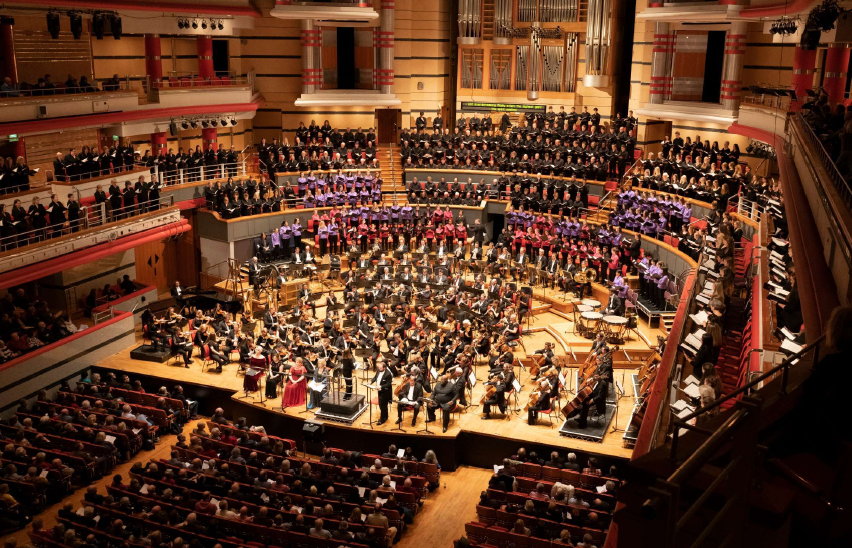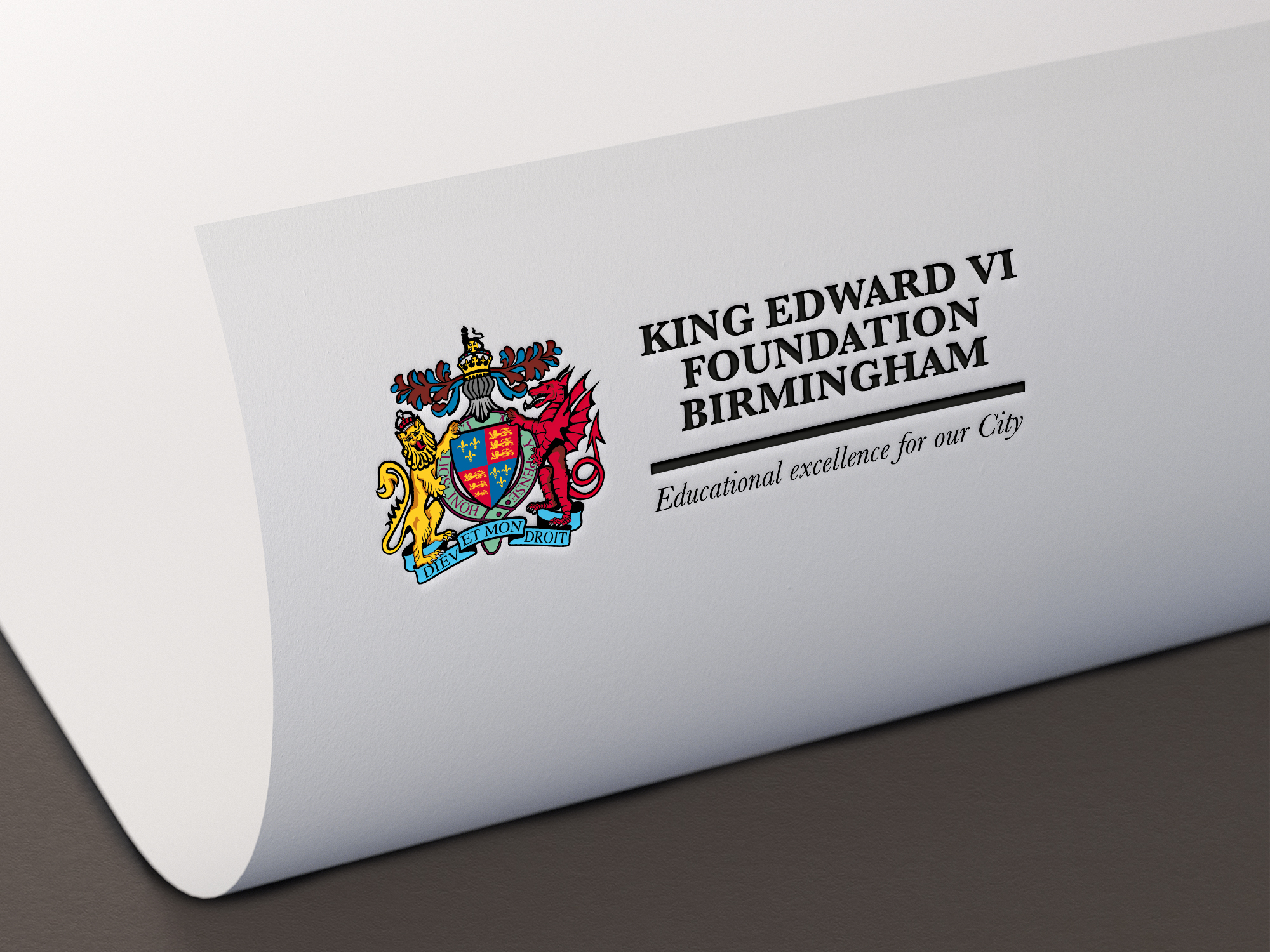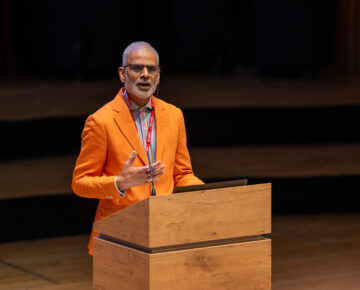Year 10 Student Holly Mia Garside of King Edward VI Camp Hill School for Girls was lucky enough to have performed Mahler Symphony No. 8 as part of the CBSO Youth Chorus.
Here she recounts her experience of what she describes as 'truly the peak of my experience as a musician thus far'.
Over a year ago, mere months before the first lockdown (wow that's gone by quickly), I was lucky enough to have performed Mahler Symphony No. 8 as part of the CBSO Youth Chorus, alongside CBDO Chorus, BCSO Children's Chorus, University of Birmingham Voices, Baltimore Choral Arts Society and of course CBSO itself. Conducted by the mesmerising Mirga Grazinyto-Tyla, it was truly the peak of my experience as a musician thus far, and what I consider to me a turning point in my life in so many ways.
Trisa Sivavijayakumar of 9X shares my admiration for the symphony, stating: "Mahler's Symphony of a thousand is about the journey from earth to heaven. Something that touches me even though I have never experienced such a journey. I was lucky enough to perform it among the CBSO last year! I was not used to Mahler's works before performing it; however, now I can say that I am a huge Mahler fan. My favourite bit of the symphony would have to be its climax with its magical use of percussion and brass. Mahler 8 will always have a massive place in my heart". Miss Hawthorne also made an appearance as a soprano in the CBSO Chorus, and mentioned how privileged she felt to be able to sing with us in such an exciting performance of the symphony.
I always knew that Mahler 8 had something special that separated it from other works of classical music, but only when researching for this article did I realise how extraordinary its story is.
The composition of this work, like so many great discoveries was something that happened by complete chance. In 1906, Gustav Mahler retreated to his holiday home to revise the orchestration of his previous symphony, Symphony No. 7. At this time, Mahler was struggling with a dispiriting case of writer's block: he saw a barren musical future, simply not knowing what to write next. His wife recalls him to be "haunted by the spectre of failing inspiration". Then one day during this retreat, a sudden burst of creativity overcame Mahler, and he began to outline the musical architecture of a new piece, more ambitious than any of his former works. While speaking to music historian Richard Specht amid its composition, Mahler mentioned his eighth symphony, commenting "Just think: within the last three weeks I have completed the sketch of a complete new symphony, something that makes all my other works seem like preliminary efforts". Within two months, the work was complete.
[caption id="attachment_11420" align="aligncenter" width="759"] Birmingham Symphony Hall[/caption]
It is clear that Mahler was spiritually inspired while composing this symphony, stating "On the threshold of my old workshop, the Spiritus Creator took hold of me and shook me and drove me on for the next eight weeks until my greatest work was done". The true beauty of this symphony, however, comes with the music itself. The performance begins with a shocking fortissimo octave chord on the organ, laying the tonic of the key, shortly followed by the blanket of harmony played by the organ and then sang by the chorus. This fortissimo sound from the chorus is sung to "Veni, Veni creator spiritus", a motif that can be heard throughout the first part of this symphony. Blaring brass begins a marching-style rhythm, immediately signifying a very proud tone that echoes throughout the piece. This first part is set to a 9th Century Christian hymn, 'Veni Creator Spiritus'. It is a dramatic opening which takes form into a very dramatic first half. This part ends in a very epic style, clearly shown by the score here; all parts come together (including brass sat on a storey near the roof depending on the performance you hear!) to play the tonic chord. Truly a unifying and thrilling ending.
One strange thing about the form is this symphony is that it doesn't confirm to the usual 4-movement form, instead consisting of only two parts. This was a conscious decision on Maher's part, as very early notes concerning the piece hint at it being a 4-movement symphony, but this idea was scrapped very early on in favour of the 2-part form.
The second part of this piece, "Closing scene from the Goethe's Faust", is very different from its former: overall more subdued and almost eerie to begin with. If you listen closely, you can heat echoes of the former part which ties the two pieces together. The beginning of part two completely juxtaposes the beginning of part one: pianissimo tremolos from the violin send shivers down your spin and the mystical soli from the woodwind add an otherworldly sense, reminded me personally of the magical tone of Holst's "The Planets" suite. Solis are passed around sections and each time resolving back into the humming tremolo of the violins. This calm quiet opening doesn't last long though, as the original motif played by the woodwind is repeated and followed by a subito fortissimo eruption of strings. The true emotion of this piece evolves from there until we get to what I believe to be the most incredibly emotional and climactic ending in classical music. Mahler himself believed his Eighth Symphony to be an expression of confidence in the eternal human spirit, and this ending truly displays the divine impact music can have on us.
I could talk more about the form of the music and what I think it might mean, but I don't believe I can encapsulate such a feeling into words. In the words of Hans Christian Anderson: "Where words fail, music speaks". I could talk about this piece for hours because there's just so much to discuss! From how it shows a perfect blend of the romantic and 20th/21st Century periods of music (marking the end of the former and beginning of the latter) to the emotional impact it has on the audience and players alike. Not surprisingly, this was the first musical work that Mahler composed that didn't receive any immediate, disappointing criticism: the uproarious applause from the audience lasted 20 minutes on its debut performance on the 12th September 1910. The piece has come to be known as "Symphony of A Thousand" because it requires a whopping 1029 musicians to be performed: Mahler conceptualised this as a "new symphonic universe". For me, Mahler's Symphony No. 8 is one of those very rare art forms that doesn't seem to ever become dull as there's always something new to notice upon every listen.
If you're new to the world of classical music or are thinking of getting into the world of classical music, I would highly recommend this symphony as one to begin with. It's everything I (and hopefully you) could ever want from a single symphony.
You can listen to Mahler's No. 8, being performed by the Netherlands Philharmonic Orchestra here.
Birmingham Symphony Hall[/caption]
It is clear that Mahler was spiritually inspired while composing this symphony, stating "On the threshold of my old workshop, the Spiritus Creator took hold of me and shook me and drove me on for the next eight weeks until my greatest work was done". The true beauty of this symphony, however, comes with the music itself. The performance begins with a shocking fortissimo octave chord on the organ, laying the tonic of the key, shortly followed by the blanket of harmony played by the organ and then sang by the chorus. This fortissimo sound from the chorus is sung to "Veni, Veni creator spiritus", a motif that can be heard throughout the first part of this symphony. Blaring brass begins a marching-style rhythm, immediately signifying a very proud tone that echoes throughout the piece. This first part is set to a 9th Century Christian hymn, 'Veni Creator Spiritus'. It is a dramatic opening which takes form into a very dramatic first half. This part ends in a very epic style, clearly shown by the score here; all parts come together (including brass sat on a storey near the roof depending on the performance you hear!) to play the tonic chord. Truly a unifying and thrilling ending.
One strange thing about the form is this symphony is that it doesn't confirm to the usual 4-movement form, instead consisting of only two parts. This was a conscious decision on Maher's part, as very early notes concerning the piece hint at it being a 4-movement symphony, but this idea was scrapped very early on in favour of the 2-part form.
The second part of this piece, "Closing scene from the Goethe's Faust", is very different from its former: overall more subdued and almost eerie to begin with. If you listen closely, you can heat echoes of the former part which ties the two pieces together. The beginning of part two completely juxtaposes the beginning of part one: pianissimo tremolos from the violin send shivers down your spin and the mystical soli from the woodwind add an otherworldly sense, reminded me personally of the magical tone of Holst's "The Planets" suite. Solis are passed around sections and each time resolving back into the humming tremolo of the violins. This calm quiet opening doesn't last long though, as the original motif played by the woodwind is repeated and followed by a subito fortissimo eruption of strings. The true emotion of this piece evolves from there until we get to what I believe to be the most incredibly emotional and climactic ending in classical music. Mahler himself believed his Eighth Symphony to be an expression of confidence in the eternal human spirit, and this ending truly displays the divine impact music can have on us.
I could talk more about the form of the music and what I think it might mean, but I don't believe I can encapsulate such a feeling into words. In the words of Hans Christian Anderson: "Where words fail, music speaks". I could talk about this piece for hours because there's just so much to discuss! From how it shows a perfect blend of the romantic and 20th/21st Century periods of music (marking the end of the former and beginning of the latter) to the emotional impact it has on the audience and players alike. Not surprisingly, this was the first musical work that Mahler composed that didn't receive any immediate, disappointing criticism: the uproarious applause from the audience lasted 20 minutes on its debut performance on the 12th September 1910. The piece has come to be known as "Symphony of A Thousand" because it requires a whopping 1029 musicians to be performed: Mahler conceptualised this as a "new symphonic universe". For me, Mahler's Symphony No. 8 is one of those very rare art forms that doesn't seem to ever become dull as there's always something new to notice upon every listen.
If you're new to the world of classical music or are thinking of getting into the world of classical music, I would highly recommend this symphony as one to begin with. It's everything I (and hopefully you) could ever want from a single symphony.
You can listen to Mahler's No. 8, being performed by the Netherlands Philharmonic Orchestra here.
 Birmingham Symphony Hall[/caption]
It is clear that Mahler was spiritually inspired while composing this symphony, stating "On the threshold of my old workshop, the Spiritus Creator took hold of me and shook me and drove me on for the next eight weeks until my greatest work was done". The true beauty of this symphony, however, comes with the music itself. The performance begins with a shocking fortissimo octave chord on the organ, laying the tonic of the key, shortly followed by the blanket of harmony played by the organ and then sang by the chorus. This fortissimo sound from the chorus is sung to "Veni, Veni creator spiritus", a motif that can be heard throughout the first part of this symphony. Blaring brass begins a marching-style rhythm, immediately signifying a very proud tone that echoes throughout the piece. This first part is set to a 9th Century Christian hymn, 'Veni Creator Spiritus'. It is a dramatic opening which takes form into a very dramatic first half. This part ends in a very epic style, clearly shown by the score here; all parts come together (including brass sat on a storey near the roof depending on the performance you hear!) to play the tonic chord. Truly a unifying and thrilling ending.
One strange thing about the form is this symphony is that it doesn't confirm to the usual 4-movement form, instead consisting of only two parts. This was a conscious decision on Maher's part, as very early notes concerning the piece hint at it being a 4-movement symphony, but this idea was scrapped very early on in favour of the 2-part form.
The second part of this piece, "Closing scene from the Goethe's Faust", is very different from its former: overall more subdued and almost eerie to begin with. If you listen closely, you can heat echoes of the former part which ties the two pieces together. The beginning of part two completely juxtaposes the beginning of part one: pianissimo tremolos from the violin send shivers down your spin and the mystical soli from the woodwind add an otherworldly sense, reminded me personally of the magical tone of Holst's "The Planets" suite. Solis are passed around sections and each time resolving back into the humming tremolo of the violins. This calm quiet opening doesn't last long though, as the original motif played by the woodwind is repeated and followed by a subito fortissimo eruption of strings. The true emotion of this piece evolves from there until we get to what I believe to be the most incredibly emotional and climactic ending in classical music. Mahler himself believed his Eighth Symphony to be an expression of confidence in the eternal human spirit, and this ending truly displays the divine impact music can have on us.
I could talk more about the form of the music and what I think it might mean, but I don't believe I can encapsulate such a feeling into words. In the words of Hans Christian Anderson: "Where words fail, music speaks". I could talk about this piece for hours because there's just so much to discuss! From how it shows a perfect blend of the romantic and 20th/21st Century periods of music (marking the end of the former and beginning of the latter) to the emotional impact it has on the audience and players alike. Not surprisingly, this was the first musical work that Mahler composed that didn't receive any immediate, disappointing criticism: the uproarious applause from the audience lasted 20 minutes on its debut performance on the 12th September 1910. The piece has come to be known as "Symphony of A Thousand" because it requires a whopping 1029 musicians to be performed: Mahler conceptualised this as a "new symphonic universe". For me, Mahler's Symphony No. 8 is one of those very rare art forms that doesn't seem to ever become dull as there's always something new to notice upon every listen.
If you're new to the world of classical music or are thinking of getting into the world of classical music, I would highly recommend this symphony as one to begin with. It's everything I (and hopefully you) could ever want from a single symphony.
You can listen to Mahler's No. 8, being performed by the Netherlands Philharmonic Orchestra here.
Birmingham Symphony Hall[/caption]
It is clear that Mahler was spiritually inspired while composing this symphony, stating "On the threshold of my old workshop, the Spiritus Creator took hold of me and shook me and drove me on for the next eight weeks until my greatest work was done". The true beauty of this symphony, however, comes with the music itself. The performance begins with a shocking fortissimo octave chord on the organ, laying the tonic of the key, shortly followed by the blanket of harmony played by the organ and then sang by the chorus. This fortissimo sound from the chorus is sung to "Veni, Veni creator spiritus", a motif that can be heard throughout the first part of this symphony. Blaring brass begins a marching-style rhythm, immediately signifying a very proud tone that echoes throughout the piece. This first part is set to a 9th Century Christian hymn, 'Veni Creator Spiritus'. It is a dramatic opening which takes form into a very dramatic first half. This part ends in a very epic style, clearly shown by the score here; all parts come together (including brass sat on a storey near the roof depending on the performance you hear!) to play the tonic chord. Truly a unifying and thrilling ending.
One strange thing about the form is this symphony is that it doesn't confirm to the usual 4-movement form, instead consisting of only two parts. This was a conscious decision on Maher's part, as very early notes concerning the piece hint at it being a 4-movement symphony, but this idea was scrapped very early on in favour of the 2-part form.
The second part of this piece, "Closing scene from the Goethe's Faust", is very different from its former: overall more subdued and almost eerie to begin with. If you listen closely, you can heat echoes of the former part which ties the two pieces together. The beginning of part two completely juxtaposes the beginning of part one: pianissimo tremolos from the violin send shivers down your spin and the mystical soli from the woodwind add an otherworldly sense, reminded me personally of the magical tone of Holst's "The Planets" suite. Solis are passed around sections and each time resolving back into the humming tremolo of the violins. This calm quiet opening doesn't last long though, as the original motif played by the woodwind is repeated and followed by a subito fortissimo eruption of strings. The true emotion of this piece evolves from there until we get to what I believe to be the most incredibly emotional and climactic ending in classical music. Mahler himself believed his Eighth Symphony to be an expression of confidence in the eternal human spirit, and this ending truly displays the divine impact music can have on us.
I could talk more about the form of the music and what I think it might mean, but I don't believe I can encapsulate such a feeling into words. In the words of Hans Christian Anderson: "Where words fail, music speaks". I could talk about this piece for hours because there's just so much to discuss! From how it shows a perfect blend of the romantic and 20th/21st Century periods of music (marking the end of the former and beginning of the latter) to the emotional impact it has on the audience and players alike. Not surprisingly, this was the first musical work that Mahler composed that didn't receive any immediate, disappointing criticism: the uproarious applause from the audience lasted 20 minutes on its debut performance on the 12th September 1910. The piece has come to be known as "Symphony of A Thousand" because it requires a whopping 1029 musicians to be performed: Mahler conceptualised this as a "new symphonic universe". For me, Mahler's Symphony No. 8 is one of those very rare art forms that doesn't seem to ever become dull as there's always something new to notice upon every listen.
If you're new to the world of classical music or are thinking of getting into the world of classical music, I would highly recommend this symphony as one to begin with. It's everything I (and hopefully you) could ever want from a single symphony.
You can listen to Mahler's No. 8, being performed by the Netherlands Philharmonic Orchestra here. 








